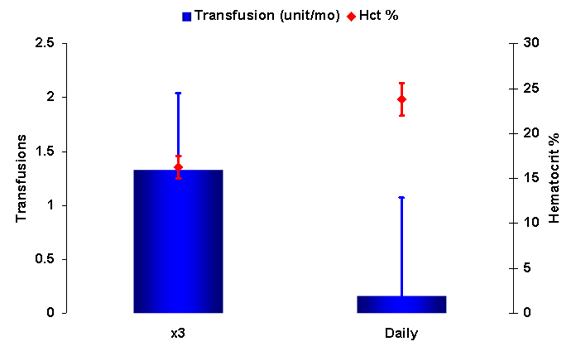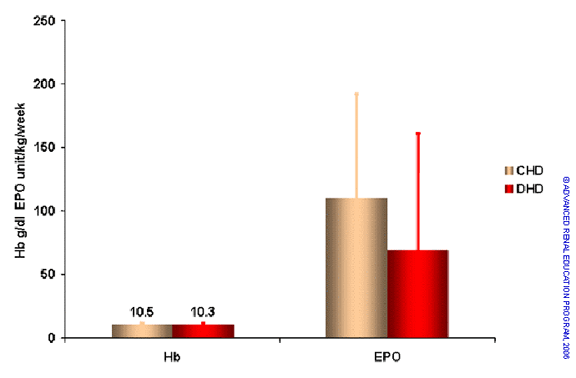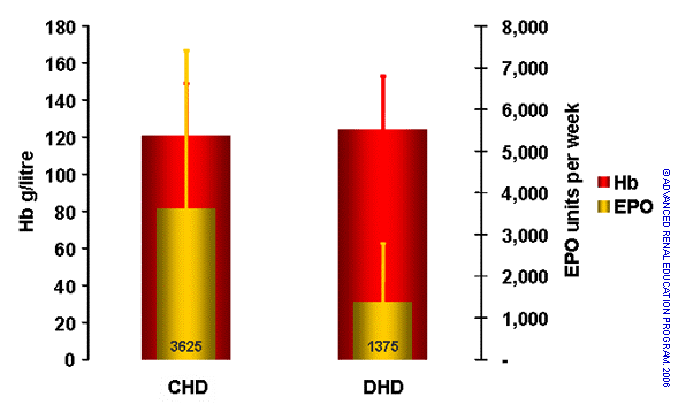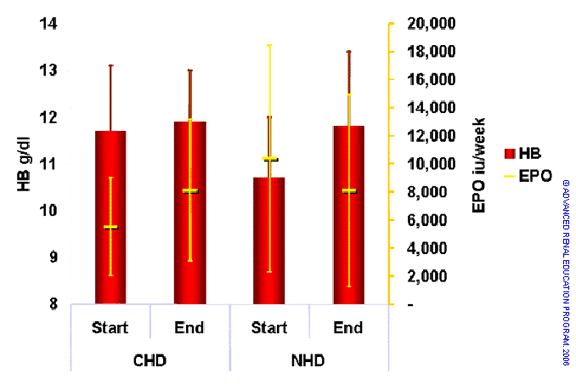Anemia Management
It is interesting that as early as 1972 and pre-EPO era, daily HD was shown to significantly reduce transfusions, while increasing hematocrit (Hct) (1).
 The effect of daily HD on anemia management in the pre-EPO era (1).
The effect of daily HD on anemia management in the pre-EPO era (1).
Patients treated by DHD spontaneously and without EPO, raised their Hct from 15 to almost 25% and had a greatly reduced requirement for blood transfusions. It is also notable that the Lecce experience associated improved anemia control without EPO in response to increased dialysis frequency (2).
The variables in assessing anemia and its response to treatment are far more complex. Responsiveness to EPO is affected by the state of repletion of hematinics such as iron and vitamin cofactors, whereas norms for measures of hematinic status differ in ESRD patients and normals. EPO resistance also occurs in patients affected by microinflammation. It is probable that the response to EPO is inhibited by one or more retained uremic toxins, as yet unidentified. These factors probably contribute to the large variance observed when EPO dose and EPO responses are measured in any ESRD population. In the midst of so many potential confounders it is difficult to assess a specific effect of increased dialysis frequency on anemia management without tightly controlled and specifically designed trials: these are not available to date.


 Selected examples of data indicating the impact of frequent HD on anemia management from various series (3-5)
Selected examples of data indicating the impact of frequent HD on anemia management from various series (3-5)
Where EPO responsiveness and anemia management has been reported in patients treated with increased dialysis frequency, the trend of the data suggests that these regimes result in a rise in hemoglobin at no cost in increased EPO, or, that hemoglobin (or hematocrit) is maintained at lower dose of EPO. The trend of the data, although generally lacking statistical significance, is for equivalent or higher hemoglobin concentration associated with lesser dose requirement for EPO. Pending properly designed studies, the evidence for a distinct impact of frequent HD on anemia management and EPO responsiveness remains tentative.
References:
- Bonomini V, Mioli V, Albertazzi A, Scolari P. Daily-dialysis programme: Indications and results. Proc Eur Dial Transplant Assoc 9:44-52, 1972
- Mastrangelo F, Alfonso L, Napoli M, DeBlasi V, Russo F, Patruno P. Dialysis with increased frequency of sessions (Lecce dialysis). Nephrol Dial Transplant 13 (Suppl 6):139-147, 1998
- Fagugli RM, Reboldi G, Quintaliani G, Pasini P, Ciao G, Cicconi B, Pasticci F, Kaufman JM, Buoncristiani U. Short daily hemodialysis: Blood pressure control and left ventricular mass reduction in hypertensive hemodialysis patients. Am J Kidney Dis 38:371-376, 2001
- Chan CT, Floras JS, Miller JA, Richardson RM, Pierratos A. Regression of left ventricular hypertrophy after conversion to nocturnal hemodialysis. Kidney Int 61:2235-2239, 2002
- Galland R, Traeger J, Arkouche W, Cleaud C, Delawari E, Fouque D. Short daily hemodialysis rapidly improves nutritional status in hemodialysis patients. Kidney Int 60:1555-1560, 2001
